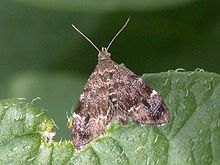- Choreutidae
-
Choreutidae "Nettle-tap Moth" Scientific classification Kingdom: Animalia Phylum: Arthropoda Class: Insecta Order: Lepidoptera (unranked): Ditrysia Superfamily: Choreutoidea Family: Choreutidae
Stainton, 1854Subfamilies and genera Millieriinae
Brenthiinae
- Brenthia Clemens, 1860
- =Microaethia Chambers, 1878
- Litobrenthia Diakonoff 1978
Choreutinae
- Alasea Rota, 2008
- Anthophila Haworth [1811]
- Asterivora Dugdale, 1979
- Caloreas Heppner, 1977
- Choreutis Hübner [1825]
- =Choreutidia Sauber, 1902
- =Hemerophila Fernald, 1900
- =Allononyma Busck, 1904
- =Macropia Costa, 1836
- Hemerophila Hübner [1817]
- ?Melanoxena Dognin, 1910
- Peotyle Diakonoff, 1978
- Prochoreutis Heppner, 1981
- Rhobonda Walker, 1863
- Saptha Walker, 1864
- =Badera Walker, 1866
- =Chordates Snellen, 1877
- Tebenna Billberg, 1820
- =Porpe Hübner, 1825
- Trichocirca Meyrick, 1920
- Telosphrantis Meyrick, 1932
- Tortyra Walker, 1863
- =Choregia Zeller, 1877
- =Walsinghamia Riley, 1889
- Zodia Heppner, 1879
Diversity 402 species Choreutidae, or "metalmark moths," are a family of insects in the lepidopteran order whose relationships have been long disputed. It was placed previously in the superfamily Yponomeutoidea in family Glyphipterigidae and in superfamily Sesioidea. It is now considered to represent its own superfamily (Minet, 1986). The relationship of the family to the other lineages in the group "Apoditrysia" [1] need a new assessment, especially with new molecular data.
Contents
Distribution
The moths occur worldwide, with 19 genera in three subfamilies defined by the structural characteristics of the immature stages (larvae and pupae), rather than the characters of the adults (Heppner and Duckworth, 1981; Rota, 2005).
Behaviour
These small moths often bear metallic scales[2] and are mostly day-flying (some also come to lights), with a jerky, pivoting behaviour, and may fluff up their wings at an extreme angle. Some tropical exemplars such as the genus Saptha are quite spectacular, with bright green metallic bands [3]. The members of the genus Brenthia, usually placed in their own subfamily Brenthiinae, have eyespots on the wings and have been shown to mimic jumping spiders (Rota and Wagner, 2006).
Larval hostplants
Most species skeletonize leaves often among silken webbing [4] whereas the western Palaearctic Millieria are leaf miners on the plant genus Aristolochia. Other Millieriinae (a subfamily defined mainly on larval characters) feed on palms (the genus Phormoestes on Sabal), whilst that of the Chilean genus Nyx is unknown. The foodplants of many Choreutinae occurring in the temperate region and some tropical species are known [5], being dominated by Asteraceae, Betulaceae, Boraginaceae, Dipterocarpaceae, Fabaceae, Labiatae, Moraceae (mainly Ficus), Rosaceae, Sapindaceae and Urticaceae. The European "Nettle-tap Moth" Anthophila fabriciana (Linnaeus, 1767), illustrated here [6] is a familiar sight pirouetting around "stinging nettles" Urtica and nearby flowers while Choreutis pariana[7] skeletonizes apple leaves. The last genus has 85 species worldwide one of which C.tigroides is a pest of "jackfruit" Artocarpus (Dugdale et al., 1999).
References
- Dugdale, J.S., Kristensen, N.P., Robinson, G.S. and Scoble, M.J. (1999) [1998]. The smaller microlepidoptera grade superfamilies, Ch.13., pp. 217–232 in Kristensen, N.P. (Ed.). Lepidoptera, Moths and Butterflies. Volume 1: Evolution, Systematics, and Biogeography. Handbuch der Zoologie. Eine Naturgeschichte der Stämme des Tierreiches / Handbook of Zoology. A Natural History of the phyla of the Animal Kingdom. Band / Volume IV Arthropoda: Insecta Teilband / Part 35: 491 pp. Walter de Gruyter, Berlin, New York.
- Heppner, J. B. and W. D. Duckworth (1981). Classification of the superfamily Sesioidea (Lepidoptera: Ditrysia). Smithsonian Contributions to Zoology 314: 1-144.
- Minet, J. (1986). Ébauche d'une classification moderne de l'ordre des Lépidoptères. Alexanor 14(7): 291-313.
- Rota, J. (2005) Larval and Pupal Descriptions of the Neotropical Choreutid Genera Rhobonda Walker and Zodia Heppner (Lepidoptera: Choreutidae) Annals of the Entomological Society of America, 98: 37-47. Abstract
- Rota, J. and Wagner, D.L. (2006). Predator Mimicry: Metalmark Moths Mimic Their Jumping Spider Predators. PLoS ONE, 1(1): e45. Published online 20 December 2006. doi: 10.1371/journal.pone.0000045.Abstract/pdf
Sources
- Firefly Encyclopedia of Insects and Spiders, edited by Christopher O'Toole, ISBN 1-55297-612-2, 2002
External links
- Tree of Life
- Fauna Europaea
- UK Moths Choreutidae
- Markku Savela's website
- Natural History Museum hosts database
- Lepindex Available Names
- Saptha libanota
- Saptha exanthista
- Saptha exanthista
- Choreutidae New Guinea
- UK Moths Prochoreutis sehestediana
- Delta Key
- La Selva Costa Rica species
- Pheromones of Anthophila
- Pheromones of Prochoreutis sehestediana
- US leaf damage Millieria
- Larvae and cocoons
- Representative genera
- Choreutinae resting postures
- Quicktime movie of Brenthia mimicking spider
- Quicktime movie of jumping spider and appetizing moths
- Quicktime movie of jumping spider and Brenthia
Arthropoda - Insecta - Superfamilies of Lepidoptera Butterflies 
Larger Moths Bombycoidea · Calliduloidea · Cimelioidea · Drepanoidea · Geometroidea · Immoidea · Lasiocampoidea · Mimallonoidea · Noctuoidea · SphingoideaMicrolepidoptera Monotrysia: Andesianoidea · Nepticuloidea · Incurvarioidea · Tischerioidea · Palaephatoidea
Ditrysian micros: Acanthopteroctetoidea · Alucitoidea · Choreutoidea · Copromorphoidea · Cossoidea · Epermenioidea · Galacticoidea · Gelechioidea · Gracillarioidea · Hyblaeoidea · Incurvarioidea · Pterophoroidea · Pyraloidea · Schreckensteinioidea · Sesioidea · Simaethistoidea · Thyridoidea · Tineoidea · Tortricoidea · Urodoidea · Whalleyanoidea · Yponomeutoidea · Zygaenoidea
Basal lineages: Micropterigoidea · Agathiphagoidea · Eriocranioidea · Hepialoidea · Heterobathmioidea · Lophocoronoidea · Mnesarchaeoidea · NeopseustoideaCategories: - Brenthia Clemens, 1860
Wikimedia Foundation. 2010.

